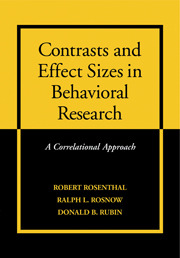1 - Basic Concepts of Focused Procedures
Published online by Cambridge University Press: 18 April 2011
Summary
This chapter discusses the basic distinction between contrasts and omnibus tests of significance. Omnibus tests seldom address questions of real interest to researchers and are typically less powerful than focused procedures. Contrasts accompanied by effect size estimates address focused questions, and the effect size tells us something very different from the p value.
FOCUSED VERSUS OMNIBUS QUESTIONS
Contrasts are statistical procedures for asking focused questions of data. Compared to diffuse or omnibus questions, focused questions are characterized by greater conceptual clarity, and the statistical procedure by greater statistical power when examining those focused questions. That is, if an effect truly exists, we are more likely to discover it and to believe it to be real when asking focused questions rather than omnibus ones. Contrast analyses yield both estimates of the magnitude of the effects investigated and the associated significance levels.
AN EXAMPLE
Suppose developmental researchers interested in psychomotor skills had a total of fifty children at five age levels (11, 12, 13, 14, 15) play a new video game. The specific question of interest to the researchers was whether age is an effective predictor of proficiency in this game. The mean performance scores of ten children at each of the five age levels were 25, 30, 40, 50, and 55, respectively. These values are plotted in Figure 1.1, whereas Table 1.1 shows the overall analysis of variance (ANOVA) computed on the individual scores.
- Type
- Chapter
- Information
- Contrasts and Effect Sizes in Behavioral ResearchA Correlational Approach, pp. 1 - 7Publisher: Cambridge University PressPrint publication year: 1999
- 1
- Cited by

